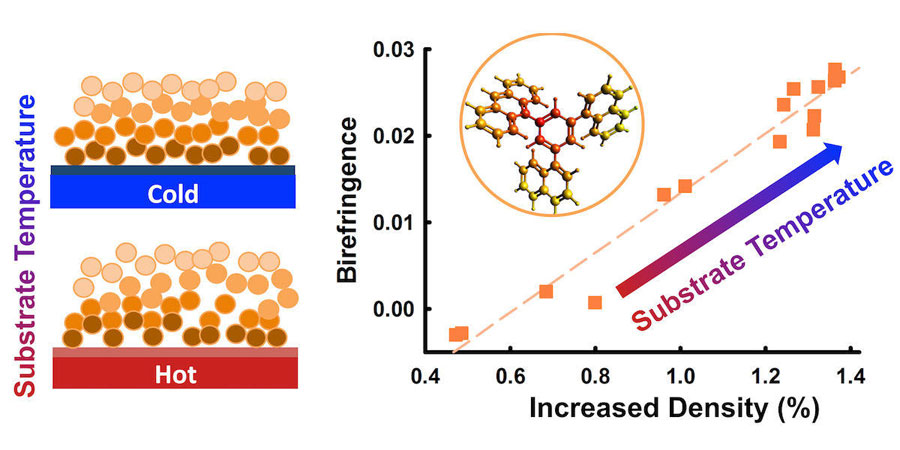
Insight into Glass Formation Could Lead to Coatings, Other Applications
To better understand the optical properties of stable glasses, and whether they are analogous to the properties of naturally aged glasses, researchers began by developing perfectly round molecules that retain their three-dimensional shape and do not preferentially align in a specific direction. The researchers produced stable glasses using these molecules, expecting that these glasses would be amorphous and isotropic.
The University of Pennsylvania research team was surprised to discover that the stable glasses produced with the spherical molecules were birefringent.
Using a combination of angle- and polarization-dependent photoluminescence and ellipsometry experiments, the team showed that these stable glasses possessed a predominantly isotropic molecular orientation while being optically birefringent. Despite measuring zero order in the glass, the researchers still saw an amount of birefringence analogous to having up to 30 percent of the molecules perfectly ordered. Experiments showed that this was due to the layer-by-layer nature of the deposition, which allowed molecules to pack more tightly in the direction normal to the surface during the deposition.
The intrinsic birefringence strongly correlated with increased density, indicating that molecular ordering was not required to produce stable glasses or optical birefringence. Researchers showed that the process could be controlled by changing the substrate temperature that controls the degree of densification.

Penn researchers found that certain optical properties in stable glasses were due to the layer-by-layer nature of the deposition that allows molecules to pack more tightly in the direction normal to the surface during the deposition. Courtesy of University of Pennsylvania.
“We were able to show that this is a unique kind of order that is emergent from the process,” professor Zahra Fakhraai said. “This is a new sort of packing that’s very unique because you don't have any orientation, but you can still manipulate the molecular distances on average and still have a random but birefringent packing overall.
“And so this teaches us a lot about the process of how you can actually access these lower state phases, but also provides a way of engineering optical properties without necessarily inducing an order or structure in the material.”
Since the stressors are distributed differently in and out of plane, glasses could have different mechanical properties, which could be useful in the development of coatings. For example, it could be possible to manipulate the orientation of a glass or its layering to give it anti-scratch properties.
“We expect that if we were to indent the glass surface with something, it would have different toughness versus indenting it on the side. This could change its fracture patterns or hardness or elastic properties. I think understanding how shape, orientation and packing could affect the mechanics of these coatings is one of the places where interesting applications could emerge,” said Fakhraai.
The team hopes that it can apply what it has learned about the process of stable glass formation to the study of highly aged glass.
According to Fakhraai, one of the most exciting aspects of the research is the ability to show that there can be amorphous phases that are high density.
“This tells us that we can actually make glasses that have packings that would be relevant to very well-aged glass,” she said. “This opens up the possibility of better fundamentally understanding the process by which we can make stable glasses.”
The research was published in Physical Review Letters (doi: 10.1103/PhysRevLett.119.095502).
Published: September 2017